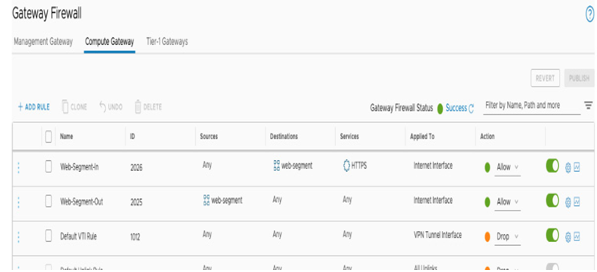We have the application VMs turned on now. By default, VMs can communicate with each other inside the same segment but are not allowed to receive connections from any external networks. Now let us enable external connectivity to the web server VM. To do that, we will configure firewall rules using the Gateway Firewall and we will configure the following:
- Allow access from the web server VM to all external destinations
- Allow access from the internet to the website hosted on the web server VM
Two new rules are created to allow the VMs residing on the web segment to access all destinations and ingress access for the HTTPS service (port 443), applying the rules on the internet interface, as seen in the following screenshot:

Figure 4.63 – Connected VPC
Now let us enable external internet access through destination NAT toward the web-app server VM to make the website available for users:
- First, we’ll request a new public Elastic IP (EIP) in the Public IPs section and assign it a descriptive name, as seen in the following screenshot:

Figure 4.64 – Connected VPC
2. Second, create a destination NAT rule in the Internet NAT rules section, and the rule will map the internal IP address of the web-app VM to the EIP and forward port 443 traffic toward it:

Figure 4.65 – Connected VPC
Now the application will be accessible from the internet using the EIP.
Summary
In this chapter, you got familiar with the steps required to start consuming VMware Cloud on AWS, including onboarding to the CSP portal, provisioning your first SDDC, providing access to the SDDC management components, and deploying your first application.
In the next chapter, you will learn how to manage a Software Defined Data Center (SDDC), VM storage policies, compute policies, and the Elastic Distributed Resource Scheduler (EDRS) mechanism for automatically scaling the cluster based on resource usage through the VMware Cloud Services Console.
You will also learn about the essential management of workloads, vSAN storage, and hosts and clusters required for day-to-day operations.